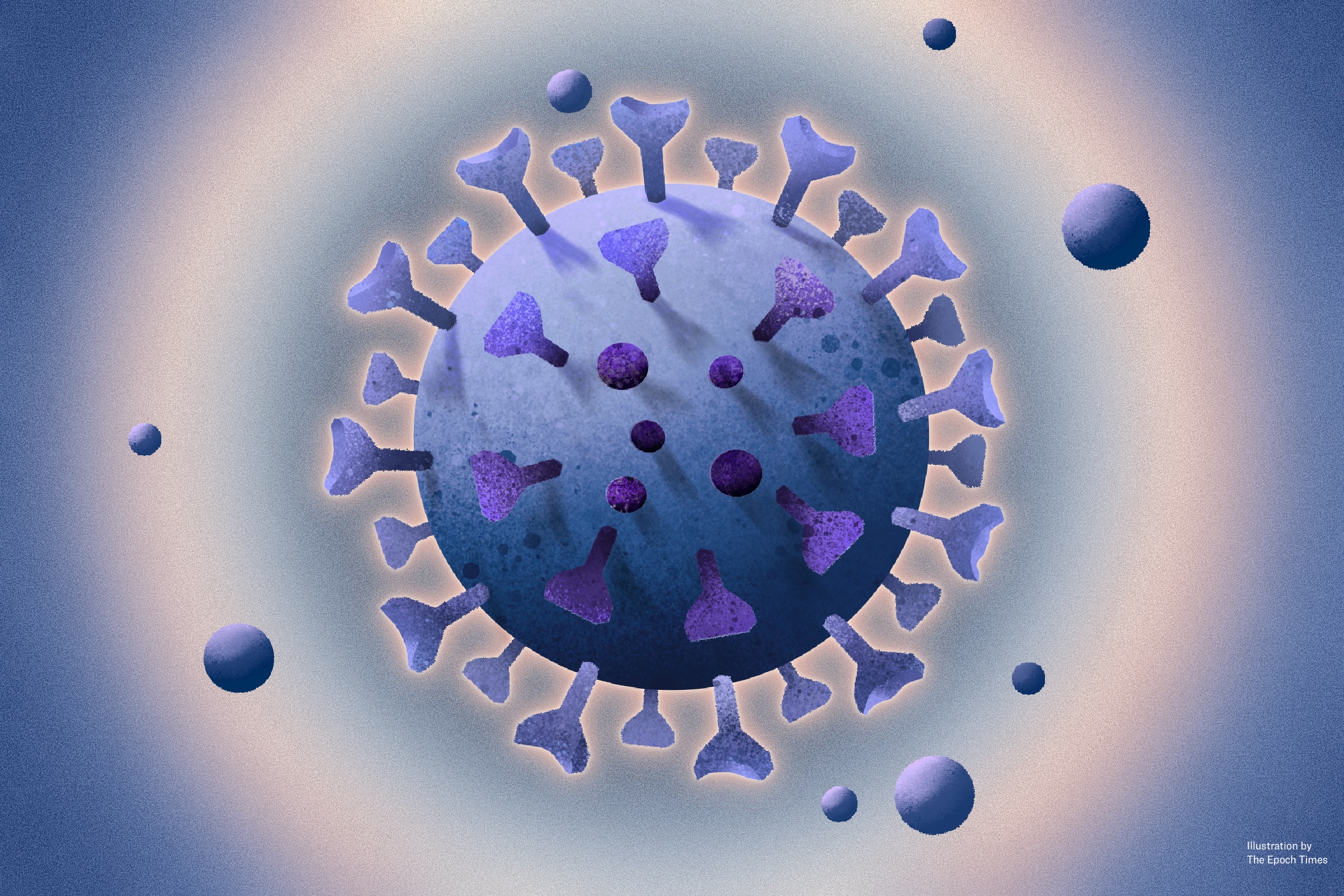
We are not clear on how it was done, but we can narrow it down to the Wuhan lab as the only plausible option.
Whatever happened, it was plausibly accidental or plausibly reckless. The end result was transmission. however, i do think that was very much deliberate as it was somehow introduced universally even if it was often ineffective.
the real problem is that it provided cover for the JAB.
The Origin of COVID: Beyond Natural and Lab Theories
The hot debate over the origin of the COVID-19 virus has persisted for four years. How can we reconcile countervailing views?
By Yuhong DongM.D., Ph.D.
|
September 14, 2024Updated:September 15, 2024
https://www.theepochtimes.com/health/the-origin-of-covid-beyond-natural-or-lab-theories-there-is-a-third-possibility-5671611
The COVID-19 pandemic has come to an end. The number of acute cases has substantially decreased, people are returning to the office, and its prevalence in social media has all but dried up, with a potential new pandemic waiting on the horizon. However, before we move on, it’s important to reflect and ask: What caused the biggest pandemic of the 21st century?
After four years the question of how the virus found its way to humans has yet to reach a definitive conclusion.
There are currently two prevalent theories: One involves natural origins and the other involves lab derivation. Many have overlooked alternative possibilities that lie beyond the natural and lab-based explanations.
Unicorn VirusMuch like the mythical unicorn, which represents something rare and extraordinary, the COVID-19 virus poses a unique set of challenges and dangers unlike those presented by any other virus we have encountered, making it a formidable and unprecedented threat to global health.
The COVID-19 virus’s unprecedented features—pathogenicity and transmissibility—are beyond what any virologist or doctor has previously encountered.
The original Wuhan COVID-19 virus could spread widely throughout the body, starting in the lungs and affecting various vital organs, including the brain, heart, blood vessels, liver, kidneys, and intestines.
Other viruses, such as the SARS virus, can also affect multiple organs, though not as broadly or severely as COVID-19. Most SARS complications have been self-limiting or reversible, although serious illness can sometimes result. In contrast, lethal complications such as heart failure, acute cardiac injury, and pulmonary embolism have been more commonly reported in COVID-19 patients. The flu virus infects far fewer organs and is much less severe than the original Wuhan COVID-19 virus.
COVID-19 can attack almost every part of the body due to several key factors:ACE2 receptor binding: The virus has used its key—or spike protein—to bind to the angiotensin-converting enzyme 2 (ACE2) receptor, which is the gatekeeper of our cells, allowing the virus entrance.
Inflammation and cytokine storm: Once inside, the spike protein triggers inflammation, which can cause an extreme immune response (cytokine storm) that can lead to multiple organ failure.
Blood vessel damage: The spike protein can damage blood vessels, causing blood clots in vital organs that can lead to severe complications such as heart attack, stroke, and sudden death.
1. Natural Origin TheoryOne of the major proposed causes of COVID-19 is rooted in a natural origin.
The virus can’t survive outside of a living organism—coronaviruses that cause severe diseases in humans usually have a natural reservoir, which is often bats. These reservoirs allow the virus to persist in nature and occasionally jump to humans or other animals, leading to outbreaks.
However, before they can cause disease in humans, an intermediate host is also needed. For example, the intermediate hosts of SARS and MERS are civets and camels, respectively.
For COVID-19, however, there are two key reasons why many challenge the natural origin possibility.
No Confirmed Natural Host
Despite extensive investigative efforts, no animals have been confirmed as the natural host of COVID-19.
The COVID-19 virus cannot infect bat cells directly, suggesting that bats are unlikely to be its natural host.
Peter Daszak’s publication has indicated that the COVID-19 virus was not found in pangolins (scale-covered mammals) in the wild or trade markets, so they are unlikely to be the intermediate host of the COVID-19 virus. Furthermore, pangolins live remotely from humans and are, therefore, unlikely to serve as intermediate hosts.
Uncommon animals traded at the Huanan Seafood Market, where most of the initial human cases were centered around, were initially assumed to be potential hosts of the virus. Some environmental swab samples from the market tested positive. However, no samples collected from those animals were found to carry the virus.
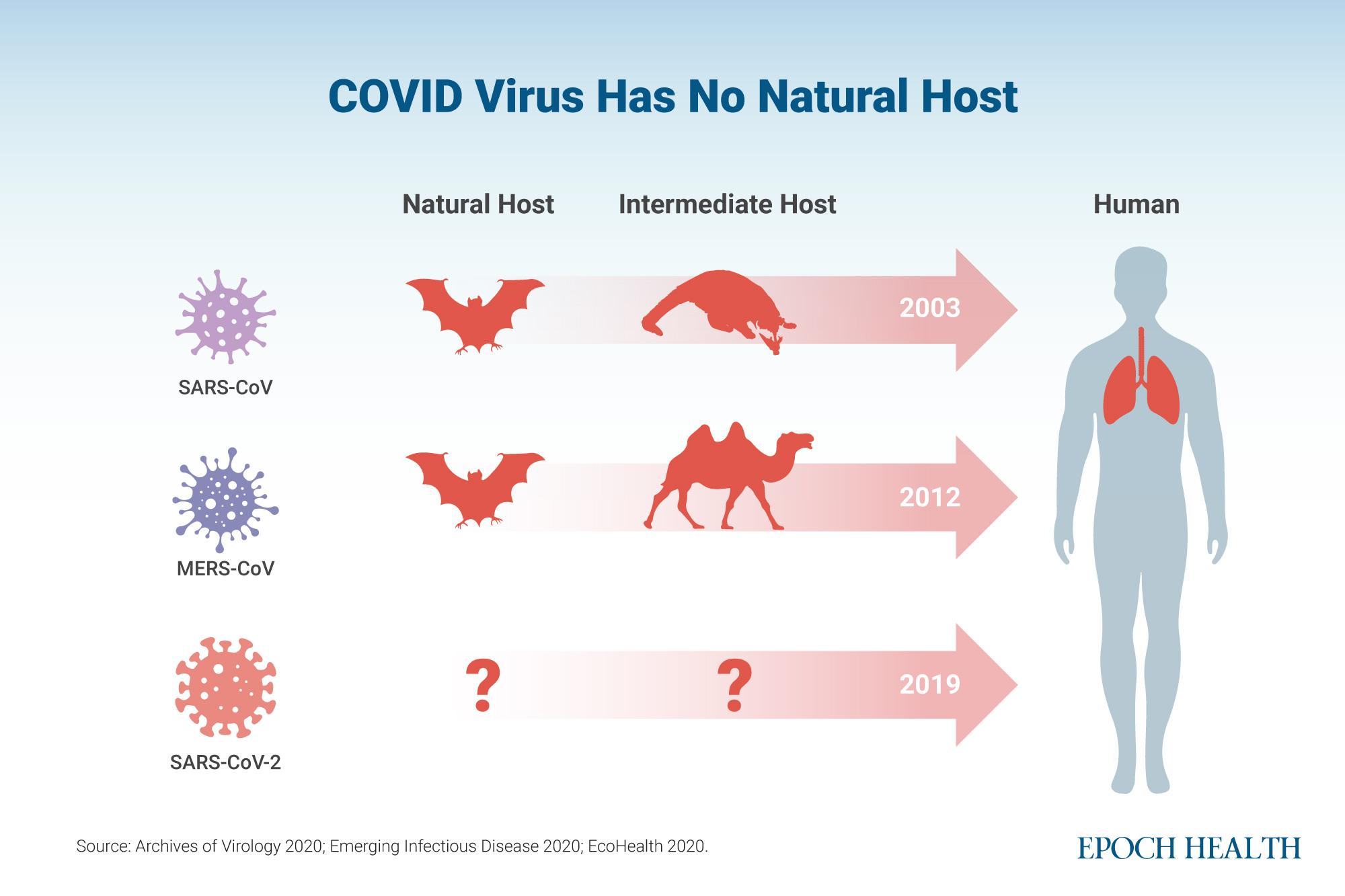
Unlike SARS and MERS, no animals have been confirmed as the natural host of the COVID-19 virus, despite extensive investigative efforts. Illustration by The Epoch Times, Shutterstock
Furthermore, the so-called “patient zero” and one-third to half of the first batch of reported patients had no exposure to the Huanan Seafood Market. This fact suggests that the virus may have circulated in the community before being detected at the market.
Looking back, Jesse D. Bloom from Fred Hutchinson Cancer Research Center, identified a deleted dataset containing COVID-19 virus sequences from even earlier Wuhan epidemic patients, which he recovered from the National Institutes of Health’s archived database. Bloom conducted a genomic analysis, reaffirming that the Huanan Seafood Market was not the initial source of the virus outbreak.
Even though the virus’s spike protein can infect ferrets and cats, there is no convincing epidemiological or genomic evidence that these animals contributed to the early stages of the COVID-19 outbreak.
Unique Features Defy OddsAll coronaviruses have a spiky crown composed of spike proteins. The spike protein is divided into two parts: S1 and S2.S1 is the binding component analogous to the biting of a door key, which inserts into the lock. It allows for the virus to attach to host cells.
S2 acts as the key’s base, or bow, supporting S1 and facilitating the unlocking process.The “keys” of the COVID-19 virus—specifically, its spike protein—can be inserted into the lock via ACE2 receptors in our bodies more easily and quickly than those of other close relatives. This contributes to its high transmissibility and widespread impact.
After the COVID-19 virus initially attaches to the ACE2 receptor, a “scissor” enzyme called FURIN in the human body cuts between the S1 and S2 of the spike protein. This cleavage allows the virus to bind to ACE2 more seamlessly. The S2 subunit then fuses with the human cell membrane, stabilizing the binding of the S1 subunit with ACE2.
Scissors function like keys with sawtooth patterns that fit perfectly into locks. Strikingly, the COVID-19 virus has precisely the required human scissor-cut point—12 additional nucleotides—in the location between the S1 and S2 subunits of its spike protein. This insertion is perfectly positioned for human enzymes to cleave the spike protein efficiently, which helps the virus enter human cells.
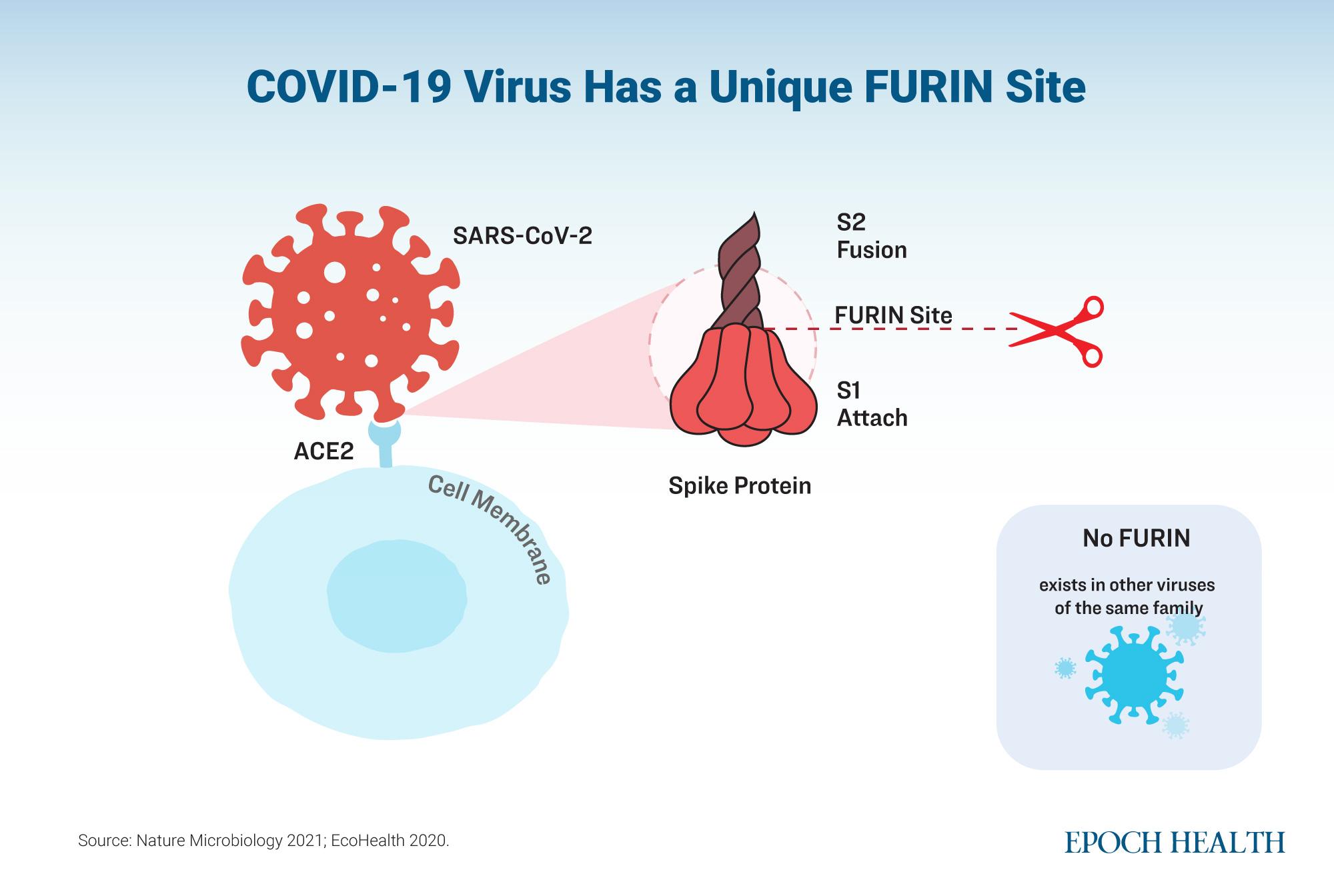
Among the betacoronavirus family, only the COVID-19 virus has the unique FURIN cleavage sequence. Illustratioin by The Epoch Times, Shutterstock
“SARS-CoV-2 is the only one of more than 800 known SARS-related coronaviruses that possesses an FCS [FURIN cleavage site],” stated Richard H. Ebright, Board of Governors professor of chemistry and chemical biology at Rutgers University, during a June 18 congressional hearing.
“Mathematically, this finding—by itself—implies that the probability of encountering a natural SARS-related coronavirus possessing an FCS is less than one in 800,” he added.
Other unique genetic codes of the COVID-19 virus have further reduced the odds of natural evolution.
“Based on these features,” the probability of it having naturally evolved from its natural ancestor virus is “less than one in 1.2 billion,” according to Dr. Steven Quay, a former faculty member at Stanford University School of Medicine, who testified at the hearing, supported by his analytical report.
This number is roughly calculated based on the phylogenetic tree theory. Even the genes of its closest relative virus, RaTG13—claimed to be the ancestor of COVID-19 by virologists from Wuhan—are only 96 percent identical to the COVID-19 virus, with more than 1,000 nucleotide differences.
According to molecular clock theory, it would take a long time—potentially several hundred thousand years—for the virus RaTG13 to naturally evolve into COVID-19, and there is no evidence to support such a lengthy evolutionary period. Consequently, scientists do not convincingly regard RaTG13 as the ancestor virus of COVID-19.
To put it simply, virologists cannot identify a reasonable ancestor virus for the COVID-19 virus based on current scientific theories. Nevertheless, there is some debate over these calculations, and not all experts rule out natural evolution.
Meanwhile, the Wuhan Institute of Virology (WIV) was located in the same city where the COVID-19 pandemic originated. WIV has a long history of researching bat-related coronaviruses and SARS-like viruses. The institute has also done a significant amount of gain-of-function (GOF) research, which involves enhancing a virus’s functions.
The WIV naturally drew the world’s attention and became the focal point of the origin debate for the COVID-19 pandemic.
2. Lab Origin TheoryBefore we delve into lab origin, we should make one thing clear: Whether the COVID-19 virus came from the Wuhan lab or not, the lab’s history of risky and unethical research—which operates under the Chinese Communist Party (CCP)—is a root problem that needs to be dealt with.
The COVID-19 outbreak originated in a city where the world’s most advanced laboratory research on SARS-like viruses has been conducted. This is the main reason the lab-origin scenario was considered.
Risky ResearchIn the Wuhan lab, virologists have used bat coronaviruses to manipulate SARS-like viruses for at least a decade.
In 2010, for the first time, Wuhan virologists discovered that coronaviruses use the spike protein as a key to bind to ACE2 receptors, which are widely distributed on the surface of the cells of the body’s vital organs.
In 2013, they isolated a specific bat coronavirus (WIV1) that bore a type of spike protein that can bind to human ACE2.
In 2015, they edited the genes of natural viruses and engineered a new SARS-like virus that can infect human cells and jump from animals to humans.
A leaked NIH report reported that WIV created novel SARS-like viruses that can reproduce up to 10,000 times more copies of the original virus in genetically engineered mice expressing human ACE2 receptors, mimicking the human infection.
Apart from the naturally occurring bat virus (WIV1), the other coronaviruses found to bind to human ACE2 receptors are the SARS virus, COVID-19 virus, and the purported four created by the WIV through GOF studies—the three viruses mentioned in the above leaked NIH report and the SHC014-MA15 virus reported in the 2015 Nature Medicine study.
In 2021, The Intercept released a leaked research proposal called DEFUSE, submitted in 2018. This proposal contained a gain-of-function research plan to insert the specific cleavage site—FURIN—into the virus genes.
Though the viruses engineered by WIV have not been proven to be the same as those of COVID-19 viruses, WIV intends to alter and enhance the functions of bat coronaviruses.
Some argue that research conducted by WIV was done to better understand natural coronaviruses and their transmission with no surreptitious motives.
Eventful Period: October Through November 2019CCP reported that the first case of COVID-19 occurred on Dec. 1, 2019, with the Wuhan Huanan Seafood Market as ground zero.
Multiple investigative reports have revealed that a severe, mysterious infection had already silently emerged in Wuhan at least two months before.
1. A group of U.S. scientific researchers, mainly from the University of California San Diego, examined the genomic data from the first cases of COVID-19 and used a scientific model to determine when the virus started infecting people. Their study suggests infection began between mid-October and mid-November 2019 in Hubei Province, China.
It should be noted that this and other genomic studies were retrospective and can’t definitively confirm transmission, although these findings point to the possibility.
2. According to the China surveillance data of Wuhan influenza-like-illness (ILI) presented to the World Health Organization (WHO), a steep increase (Fig. 1) appeared in the last week of November 2019 (Nov. 24–30), rapidly exceeding the trend across 2016–2018.
If that week’s ILI cases were caused by COVID-19 infection, considering an incubation period of two to 14 days, the infection-occurring period would fall into the week of Nov. 16 or earlier—the same time frame as reported by the above-mentioned U.S. genomic study report.
Moreover, the WHO report also highlighted an unexplained increase (Fig. 2C) in lab test-negative ILI cases in Wuhan in mid-November 2019. Meanwhile, a 2022 published study indicates that those influenza-negative ILI cases may have served as potential COVID-19 transmission.
3. Diplomats stationed at the U.S. Consulate General in Wuhan attested valuable first-hand experience of an unusual, mysterious outbreak in Wuhan in October 2019. Subsequently, U.S. personnel decamped from China.
The deputy consular chief at the U.S. Consulate in China, Russell J. Westergard, later wrote in State Magazine:
“By mid-October 2019, the dedicated team at the U.S. Consulate General in Wuhan knew that the city had been struck by what was thought to be an unusually vicious flu season. The disease worsened in November. When city officials began to close public schools in mid-December to control the spread of the disease, the team passed the word to Embassy Beijing and continued monitoring.”
4. A surveillance report on sewage by the Italian Department of Environment, Health, and Nutrition, and Veterinary Public Health indicates that traces of the COVID-19 virus had been found in wastewater samples from Italy as early as Dec. 18, 2019.
There is a potential answer for how COVID-19 cases could have come to Europe so early:
The 2019 Military World Games—a kind of Olympics for soldiers—was held in Wuhan starting Oct. 18 and lasted nine days. Nearly 10,000 military athletes from more than 100 countries, including those from major European countries, participated.
It is reported that athletes from Germany, Italy, France, and Sweden became ill after their trip to Wuhan. Notably, these countries were the hardest hit early in the pandemic.
The Missing Pieces in Lab Origin
Put simply, the Chinese lab has been conducting risky studies. Additionally, the CCP appears to have been hiding the facts about when COVID-19 first started—as they have a record of doing with other outbreaks, such as the 2003 SARS outbreak.
Therefore, many scientists have leaned toward the Wuhan lab leak hypothesis.
However, one question is overlooked: Were the WIV virologists even capable of creating the COVID-19 virus, the virus that infected hundreds of millions of people worldwide, paralyzing the world’s economy and causing the biggest pandemic since the Spanish Flu in 1918?
There is no smoking gun-level evidence that WIV created the same virus as COVID-19. The viruses produced from the GOF research found in WIV are still very different from the COVID-19 virus, though they have similar features.
The odds of fabricating the unique composition of the COVID-19 virus gene is around 1 in 1 billion. Could WIV virologists have beaten the odds? Do virologists have such skill to control their GOF research outcome completely?
Having a goal and experimenting in the lab doesn’t necessarily result in the desired outcome. WIV may wish to increase the function of the bat-derived coronavirus, but they might neither have been able to design the virus that caused a global pandemic nor control the outcome of their GOF research process.
Gigi Kwik Gronvall, a professor in environmental health and engineering, and a senior scholar at the Johns Hopkins Center for Health Security, commented in a Hopkins Bloomberg Public Health article, “If I was able to ‘reasonably anticipate’ what happened in the lab, I would have gotten my PhD in six months instead of four years.”
On the one hand, manipulating viruses could result in the creation of something extremely harmful; on the other hand, it may also lead to a virus that is less potent than COVID-19.
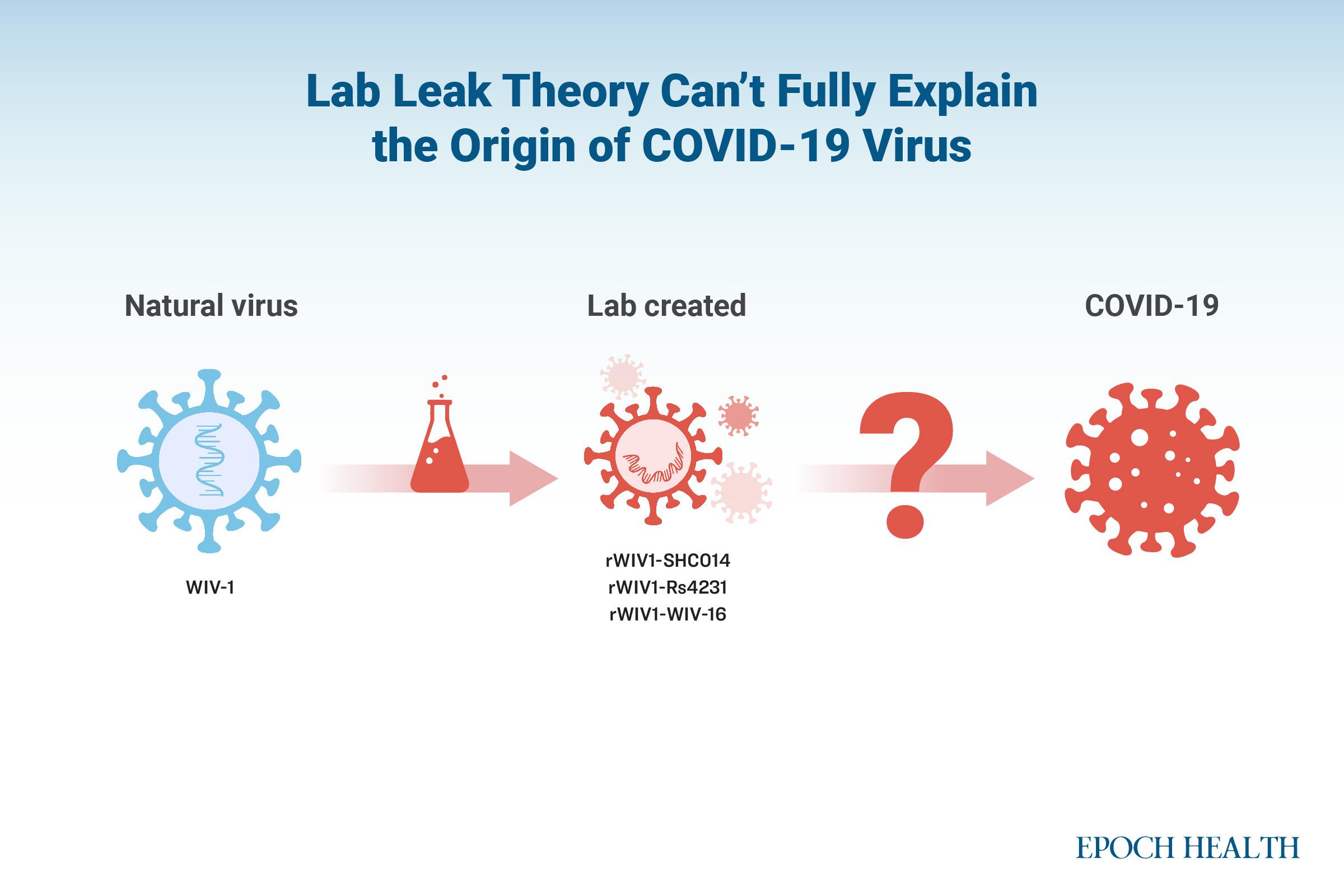
Though many scientists have leaned toward the Wuhan lab leak hypothesis, the lab-created coronaviruses were very different from the COVID-19 virus. Illustration by The Epoch Times, Shutterstock
3. Beyond Natural or Lab Origin Theory
Science can’t explain everything.
If neither the natural nor the lab origin definitively explain the emergence of the COVID-19 virus, this raises the possibility that our current scientific theories may be too limited to fully account for its origin. In other words, other options—of which we are still unaware—could be possible.
Science has greatly advanced our understanding of the world, providing explanations for countless phenomena through observation, experimentation, and empirical evidence.
Nevertheless, it has its limitations—numerous fundamental scientific questions remain unanswered.
In 2021, the journal Science published 125 questions that cannot be explained by contemporary scientific theories. These questions spanned a breadth of research, including the fields of astronomy, physics, mathematics, chemistry, medicine, life sciences, neuroscience, ecology, energy science, and artificial intelligence.
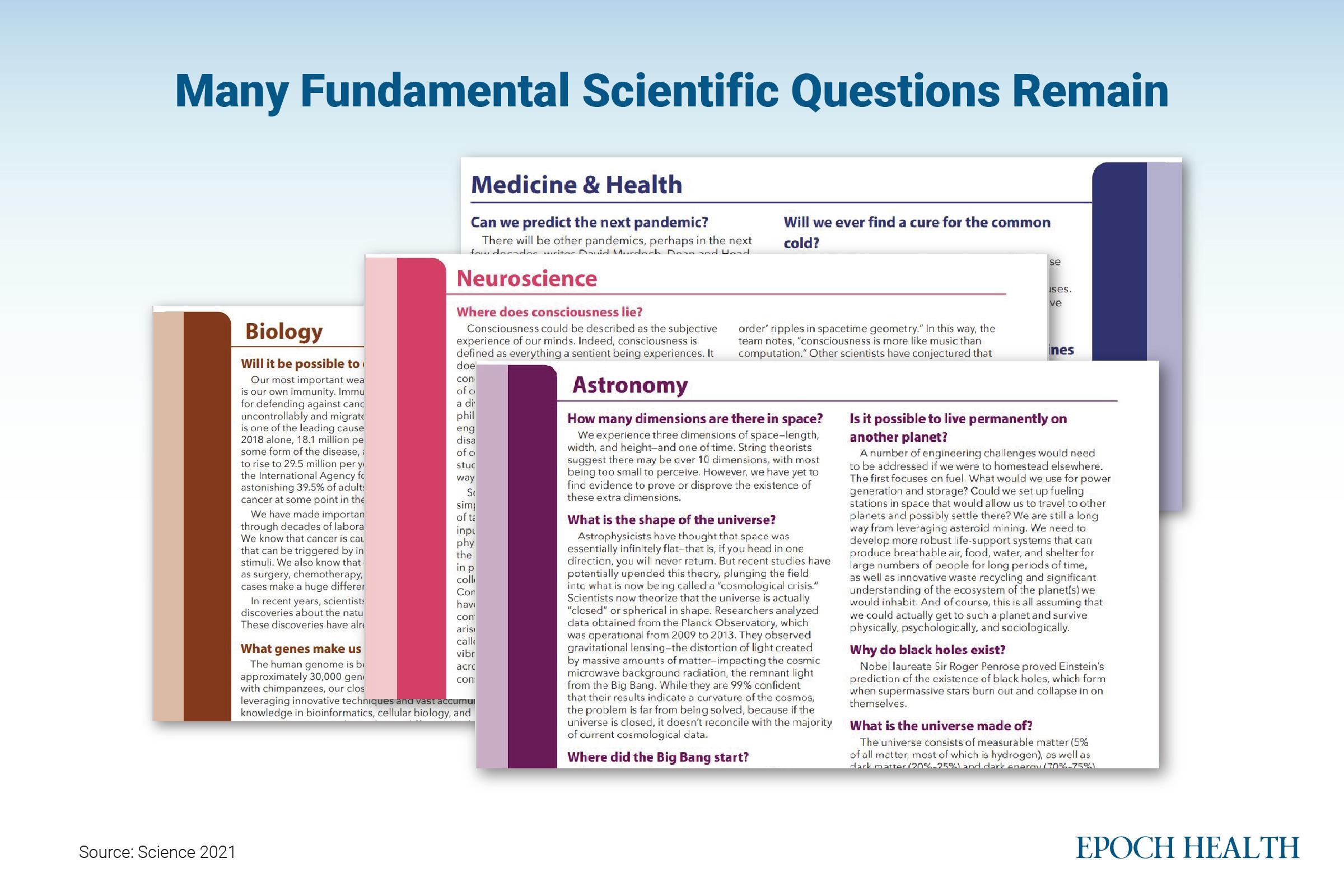
Many fundamental scientific questions remain unanswered, despite significant advances made by researchers. Screenshot via The Epoch Times
For instance, the origins of humans and human consciousness are still largely not elucidated and researchers continue to puzzle over such topics, although progress has been made in their understanding.
While Charles Darwin proposed the theory of evolution 165 years ago, he could not explain the origin of many biological species. There are numerous mysteries about species evolution that Darwin could not explain, which often frustrated him.
One notable example lies in the sudden appearance of flowering plants in the Cretaceous strata about 110 million years ago. In an 1879 letter to his close friend, botanist Dr. Joseph Hooker, Darwin referred to the rapid diversification of higher plants as an “abominable mystery.”
Such mysteries abound and underscore the limitations of contemporary science. As we continue to explore, it’s vital to acknowledge that certain higher concepts may lie beyond the reach of scientific inquiry, encouraging us to adopt a broader perspective.
When science hits a ceiling, we can better understand life’s origins only by breaking through. We need to discard outdated notions to simplify our understanding of life’s origins, including the emergence of the COVID-19 virus.
CCP Should Be Held Accountable
While the virus’s origins remain a mystery, we cannot overlook the WIV risky gain-of-function research. When humans manipulate nature without adhering to ethical guidelines, the potential for unforeseen disasters increases dramatically.
The WIV has crossed established boundaries of safety and ethics. Whether the engineered viruses are released from their labs or not, their reckless experiments have placed the global population at substantial risk.
We must conduct a thorough investigation into the lab’s documentation of the virulent viruses and animals they have been studying, as they have consistently obstructed access to experts and investigations.
Moreover, since the COVID-19 outbreak, the CCP has repeatedly delayed reporting and attempted to cover up the situation, hindering a coordinated global response.
China was once famous for its authenticity and morality. After the CCP took over in 1949, under the totalitarian regime, ethics became loose and fear rose. People with power dared to do risky things, and when disastrous events occurred, various parties involved wanted to be clear of suspicion.
Regardless of the ultimate origin of the virus, the CCP’s totalitarian regime, lack of accountability, and opaque policies have led to the harm of millions of lives. They must be held accountable for their actions.
While the CCP must be held accountable for the disastrous global impact of the COVID-19 pandemic, the ultimate origin of the virus may lie beyond the laboratory and current scientific understanding, as many unknowns still exist. It is essential for us to remain open-minded, appreciate what we have, and uphold tradition and human values to better protect ourselves from future pandemics.
No comments:
Post a Comment